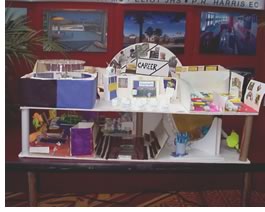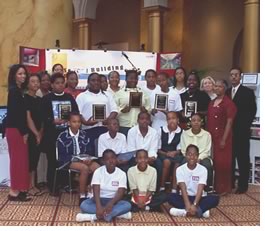

Associate Editor
Aiming to raise awareness about the link between safe and healthy schools and student achievement, the Council of Educational Facility Planners International (CEFPI) celebrated School Building Day on April 19 with a program bringing together school administrators, students, planners, architects, engineers, and government agencies to draw attention to the importance of high-quality learning facilities. The AIA partnered with the U.S. Department of Energy (DOE), U.S. Environmental Protection Agency (EPA), and other organizations on the event.
 "There
is an undeniable link between school buildings, the health of school buildings,
the health of schools, the health of children, and the productivity of
school children," remarked Steve Page, director of the EPA Office
of Radiation and Air. He and fellow speaker Mark Ginsburg, deputy assistant
secretary, DOE Office of Building Technology, State and Community Programs,
said school construction and health issues would continue to plague schools
and communities. Recent studies have shown that the average age of schools
in the U.S. is 42 years. In Washington, D.C., the crisis is especially
relevant, as almost no new public schools have been built in 40 years.
"There
is an undeniable link between school buildings, the health of school buildings,
the health of schools, the health of children, and the productivity of
school children," remarked Steve Page, director of the EPA Office
of Radiation and Air. He and fellow speaker Mark Ginsburg, deputy assistant
secretary, DOE Office of Building Technology, State and Community Programs,
said school construction and health issues would continue to plague schools
and communities. Recent studies have shown that the average age of schools
in the U.S. is 42 years. In Washington, D.C., the crisis is especially
relevant, as almost no new public schools have been built in 40 years.
Ginsburg gave reason for hope, citing examples of schools that have reduced their energy consumption by as much as 25 percent. Some facilities are installing lower wattage lightbulbs or using outdoor air for heating and cooling. One elementary school installed solar panels and tied their use to the math and science curriculum. The program had other benefits, too. Ginsburg said evidence shows that the students' math and science scores increased by 10 to 25 percent.
D.C. Public Schools
hosts event
D.C. Public Schools is embarking on an ambitious school construction program.
To underscore its efforts, the District hosted the School Building Day
program this year.
 A
group of planners and architects visited with students at several D.C.
public schools to discuss their work and the way in which school design
affects their learning environments. Following these sessions, students
were challenged to develop their "ideal learning space" in their
classroom or a special-interest area of their school. The students exhibited
their designs at an awards ceremony at the National Building Museum April
19.
A
group of planners and architects visited with students at several D.C.
public schools to discuss their work and the way in which school design
affects their learning environments. Following these sessions, students
were challenged to develop their "ideal learning space" in their
classroom or a special-interest area of their school. The students exhibited
their designs at an awards ceremony at the National Building Museum April
19.
A panel chaired by Lee Brockway, AIA, principal emeritus, Fanning/Howey Associates, and including Roger K. Lewis, FAIA, Washington Post architecture critic and professor of architecture, University of Maryland School of Architecture; R.C. Garcia, AIA, executive director, facilities management, D.C. Public Schools; Yale Stenzler, executive director of Maryland's Public School Construction Program; and Suzannah Y. Codlin, an architecture student at Howard University; juried the entries and selected the winning projects in the student design competition.
All of the finalists' boards were on display during the School Building Day award ceremony at the National Building Museum. Charles Hart Middle School, in Southeast, Washington, D.C., received top honors.
 The
jurors' comments lauded the project for flexibility of space that encourages
group work and noted that the "students displayed great interest
in diversity through their use of color, surface treatments, shapes, texture,
and visual expansion of space."
The
jurors' comments lauded the project for flexibility of space that encourages
group work and noted that the "students displayed great interest
in diversity through their use of color, surface treatments, shapes, texture,
and visual expansion of space."
Brockway commented on the innovative ideas and said "they may end up on the drawing boards as the District of Columbia embarks on an ambitious building program to renovate or build 10 schools a year over the next 10 years."
The students were proud of their design, which also featured an escalator for travel between levels and a science amphitheater with a circular seating arrangement that brings in daylight via a glass-domed roof.
School facilities
and high-performing schools
Thomas Kube, CEFPI executive director, pointed to the many challenges
facing school planners and architects today, including:
• Integrating multiple learning styles
• Delivering curriculum and using schools as a teaching tool
• Considering school size and schools within schools
• Using school buildings as community resources
• Making schools safe and secure.
 He
also noted that making schools green and employing sustainable architecture
are now as much a part of the dialogue as traditional concerns.
He
also noted that making schools green and employing sustainable architecture
are now as much a part of the dialogue as traditional concerns.
"You may know some of these statistics," Ginsburg said, "but by 2007 there are going to be 54 million school age children . . . who will be in 118,000 schools, most of these schools built before 1970, so they'll be 40 years old, requiring renovation. From 2001 to 2003, school districts will spend well over $84 million on school construction costs."
Ginsburg noted that the Department of Energy has developed a tool for architects, "Energy Guidelines for Hot and Dry Climates", part of a series of energy design guidelines for high-performing schools.
"All schools," EPA's Page said, "should be looking at designs and considering how to move themselves into the high-performing school bracket."
Copyright 2002 The American Institute of Architects. All rights reserved.
![]()
|
Council for Educational Facility Planners International Committee on Architecture for Education (CAE) Fall 2001 Conference Proceedings, "Learning Environments that Sustain: A Sustainable Future" Department of Energy Smart Schools, featuring the Design Guidelines for Hot and Dry Climates Environmental Protection Agency Office of Air and Radiation If you would like to know more about school design, why not take the "Pathway to a New Second High School" (TH23) seminar, Thursday, May 9, 4–5:30 p.m., at the AIA national convention in Charlotte, May 9 to 11? In fact, the convention is offering a number of seminars related to school design. You can see the complete list, plus registration information, by visiting the AIA Convention site. Not traveling to Charlotte? You can study school design through AIA eClassroom's distance learning courses. How about "Improved School Safety and Security Through Architectural Design" (S134)? For details and a complete course listing, visit eClassroom. |
|